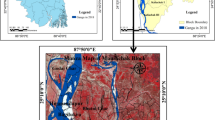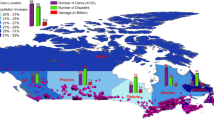Abstract
This paper presents the emergency response to the barrier lake created by the Mw 6.5 earthquake on August 3, 2014, in Niulan River which is situated in Yunnan Province, southwest China. The lake, behind 83- to 103-m-high landslide dam, has a storage capacity of 260 million m3. The Hongshiyan hydropower station, situated just upstream of the landslide dam, was submerged by the lake water. The rescue actions include building an 8-m-deep drainage channel in the flood season, draining the lake water via a water release tunnel and rebuilding the landslide dam as a permanent structure. This paper presents the considerations and processes in deciding on the emergency actions. One major consideration is to minimize the hazards caused by a possible dam break flood induced by Hongshiyan barrier lake in the flood season. It was found that the barrier lake is classified as “grade I: extremely high risk” in which the 5- and 20-year floods should be used for design and check purposes of emergency works, respectively. The dam break flood evaluations indicated that an 8-m-deep diversion channel should be constructed in order to reduce the total amount of the released reservoir storage and to prevent possible overtopping of the downstream Huangjiaoshu rockfill dam. This study was based on an improved analytical approach to dam break flood modeling and a handy spread sheet developed by the authors. The considerations on various risks and the key analytical technology for dam break flood predictions described in this paper may be useful for other similar cases.
























Similar content being viewed by others
References
Alonso EE, Pinyol NM, Puzrin AM (2010) Catastrophic slide: Vaiont Landslide, Italy. Geomechanics of failures. Advanced topics. Springer, New York, pp 33–81
Baum RL, Crone AJ, Escobar D, Harp EL, Major JJ, Martinez M, Smith ME (2001) Assessment of landslide hazards resulting from the February 13, 2001. El Salvador earthquake. US Geological Survey Open-File Report, 01-119
Bishop AW (1955) The use of the slip circle in the stability analysis of slopes. J Geotech 5(1):7–17
Bommer JJ, Benito MB, Ciudad-Real M et al (2002) The El Salvador earthquakes of January and February 2001: context, characteristics and implications for seismic risk. Soil Dyn Earthq Eng 22(5):389–418
Chen Z, Ma L, Yu S, Chen S, Zhou X, Sun P, Li X (2015) Back analysis of the draining process of the Tangjiashan barrier lake. J Hydraul Eng 141(4):05014011
Dai F, Xu C, Yao X, Xu L, Tu X, Gong Q (2011) Spatial distribution of landslides triggered by the 2008 Ms 8.0 Wenchuan earthquake, China. J Asian Earth Sci 40(4):883–895
Evans SG, Delaney KB, Hermanns RL, Strom A, Scarascia-Mugnozza G (2011) The formation and behaviour of natural and artificial rockslide dams; implications for engineering performance and hazard management. In: Natural and artificial rockslide dams. Springer, Berlin, pp 1–75
Fan X, van Westen CJ, Xu Q, Gorum T, Dai F (2012) Analysis of landslide dams induced by the 2008 Wenchuan earthquake. J Asian Earth Sci 57:25–37
Fernández B, Salas JD (1999) Return period and risk of hydrologic events. I: mathematical formulation. J Hydrol Eng 4(4):297–307
Fread DL (1984) DAMBRK: the NWS dam break flood forecasting model. National Oceanic and Atmospheric Administration, National Weather Service, Silver Spring, MD
Fread DL (1988) BREACH: an erosion model for earthen dam failures (model description and user manual). National Oceanic and Atmospheric Administration, National Weather Service, Silver Spring, MD
Furumura T, Hayakawa T (2007) Anomalous propagation of long-period ground motions recorded in Tokyo during the 23 October 2004 Mw 6.6 Niigata-ken Chuetsu, Japan, Earthquake. Bull Seismol Soc Am 97(3):863–880
Gee D (2009) Comparison of dam breach parameter estimators. World environmental and water resources congress 2009, U.S. Army Corps of Engineers, Hydrologic Engineering Center, Davis, CA, pp 1–10
Genevois R, Ghirotti M (2005) The 1963 Vaiont landslide. G Geol Appl 1:41–52
Gorum T, Fan X, van Westen CJ, Huang R, Xu Q, Tang C, Wang G (2011) Distribution pattern of earthquake-induced landslides triggered by the 12 May 2008 Wenchuan earthquake. Geomorphology 133:152–167
Havnø K, Madsen MN, Dørge J (1995) MIKE 11-a generalized river modelling package. In: Singh VP (ed) Computer models of watershed hydrology. Water Resources Publications, Colorado, pp 733–782
Hydrologic Engineering Center (HEC) (2006a) HEC-HMS user’s manual. Version 3.1.0, CPD-74A, U.S. Army Corps of Engineers, Hydrologic Engineering Center, Davis, CA
Hydrologic Engineering Center (HEC) (2006b) HEC-RAS user’s manual. Version 4.0 beta, CPD-68, U.S. Army Corps of Engineers, Hydrologic Engineering Center, Davis, CA
Jibson RW, Crone AJ, Harp EL et al (2004) Landslides triggered by the 13 January and 13 February 2001 earthquakes in El Salvador. Geol Soc Am Spec Pap 375:69–88
Kargel JS, Leonard G, Crippen RE, Delaney KB, Evans SG, Schneider J (2010) Satellite monitoring of Pakistan’s rockslide-dammed lake Gojal. EOS 91:394–395
Keefer DK (1984) Landslides caused by earthquakes. Geol Soc Am Bull 95(4):406–421
Keefer DK (2002) Investigating landslides caused by earthquakes—a historical review. Surv Geophys 23(6):473–510
Khazai B, Sitar N (2003) Evaluation of factors controlling earthquake-induced landslides caused by Chi-Chi earthquake and comparison with the Northridge and Loma Prieta events. Eng Geol 71:79–95
Kilburn CRJ, Petley DN (2003) Forecasting giant, catastrophic slope collapse: lessons from Vajont, Northern Italy. Geomorphology 54(1):21–32
Kojean E, Hutchinson JN (1978) Mayunmarca rockslide and debris flow. In: Voight B (ed) Rockslides and avalanches, Peru, vol 1. Elsevier, Amsterdam, pp 315–361
Li MH, Hsu MH, Hsieh LS, Teng WH (2002) Inundation potentials analysis for Tsao-Ling landslide lake formed by Chi-Chi earthquake in Taiwan. Nat Hazards 25(3):289–303
Liu N, Zhang JX, Lin W, Cheng WY, Chen ZY (2009) Draining Tangjiashan Barrier Lake after Wenchuan Earthquake and the flood propagation after the dam break. Sci China Ser E Technol Sci 52(4):801–809
Liu N, Chen Z, Zhang J, Lin W, Chen W, Xu W (2010) Draining the Tangjiashan barrier lake. J Hydraul Eng 136(11):914–923
Ministry of Water Resources of the People’s Republic of China (2009) Standard for classification of risk grade of landslide lake (SL 450-2009)
Moussa R, Bocquillon C (1996) Criteria for the choice of flood-routing methods in natural channels. J Hydrol 186(1):1–30
Sato HP, Hasegawa H, Fujiwara S, Tobita M, Koarai M, Une H, Iwahashi J (2007) Interpretation of landslide distribution triggered by the 2005 Northern Pakistan earthquake using SPOT 5 imagery. Landslides 4:113–122
Schneider JF (2009) Seismically reactivated Hattian slide in Kashmir, Northern Pakistan. J Seismol 13(3):387–398
Schneider JF, Gruber FE, Mergili M (2013) Recent cases and geomorphic evidence of landslide-dammed lakes and related hazards in the mountains of Central Asia. Landslide science and practice. Springer, Berlin, pp 57–64
Singh VP, Scarlatos PD, Collins JG, Jourdan MR (1988) Breach erosion of earth-fill dams (BEED) model. Nat Hazards 1(2):161–180
U.S. Army Corps of Engineers (Omaha District) (1960) Madison River, Montana—report on flood emergency Madison river slide, vol 2. Omaha, NE
Wahl TL (2004) Uncertainty of predictions of embankment dam breach parameters. J Hydraul Eng 130(5):389–397
Zhou XB, Chen ZY, Li SY, Wang L (2015) On the standard of flood return period for high risk barrier lake in emergency disposal. J Hydraul Eng 46(4):405–413 (in Chinese)
Zhu YH, Visser PJ, Vrijling JK (2004) Review on embankment dam breach modeling. New developments in dam engineering. Taylor & Francis Group, London, pp 1189–1196
Acknowledgments
The authors appreciate the guidance and assistance provided by the Emergency Disposal Headquarters of the Hongshiyan Landslide Lake and Kunming Engineering Corporation Limited, Power China. The research work was supported by the National Basic Research Program of China Grant No. 2013CB036400 and National Natural Science Foundation of China (Grant Nos. 51309260, 51309190 and 51479168).
Author information
Authors and Affiliations
Corresponding author
Rights and permissions
About this article
Cite this article
Zhou, X., Chen, Z., Yu, S. et al. Risk analysis and emergency actions for Hongshiyan barrier lake. Nat Hazards 79, 1933–1959 (2015). https://doi.org/10.1007/s11069-015-1940-2
Received:
Accepted:
Published:
Issue Date:
DOI: https://doi.org/10.1007/s11069-015-1940-2




